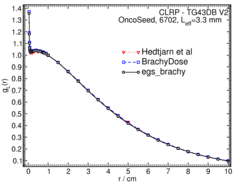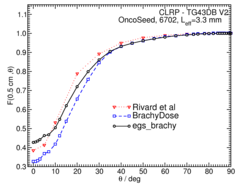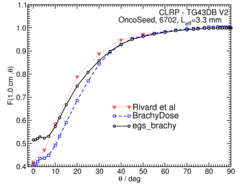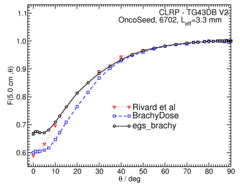
Source Description:
Dimensions for the 6702 seed are taken from the study by Daskalov et al 1 .(Note: The V1 database took the source dimensions from Williamson et al 3) This seed consists of three resin spheres (resin density is 1.2 g/cm3 and has a molecular composition of C 12 H 18 NCl), each with a diameter of 0.60 mm. The spheres are coated with 125I which is assumed to have negligible thickness in this study. The spheres are encapsulated in a titanium tube with 0.050 mm thick walls and an outer diameter of 0.80 mm. End welds are 0.50 mm thick and are modelled as 0.40 mm hemispheres on top of solid cylinders that have a 0.40 mm radius and are 0.10 mm thick. Air fills the unoccupied volumes in the seed. The overall length is 4.50 mm and the active length is 3.30 mm (calculated using the TG-43 effective line source length with a sphere spacing of 1.10 mm and N=3 sources). The maximum possible displacement of a source sphere from its nominal position is 1.70 mm along the seed axis and 0.050 mm in the radial direction, however, we assume the three beads are always centred. The mean photon energy calculated on the surface of thr source is 28.36 keV with statistical uncertainties < 0.010%.
(Note: The 2D anisotropy function values differ from the previous database (CLRPv1) by up to 20% for angles close to the source's end caps (θ ≤ 10 °) as we used an accurate source model geometry described by Daskalov et al 1, while CLRPv1 used the source model described by Williamson et al 3)
Dose-Rate Constant - Λ :
Dose-rate constants, Λ , are calculated by dividing the dose to water per history in a (0.1 mm)3 voxel centered on the reference position, (1 cm,Π/2), in the 30x30x30 cm3 water phantom, by the air-kerma strength per history (scored in vacuo). As described in ref. 4 , dose-rate constants are provided for air-kerma strength calculated using voxels of 2.66x2.66x0.05 cm3 (WAFAC) and 0.1x0.1x0.05 cm3 (point) located 10 cm from the source. The larger voxel size averages the air-kerma per history over a region covering roughly the same solid angle subtended by the primary collimator of the WAFAC 5,6 at NIST used for calibrating low-energy brachytherapy sources and is likely the most clinically relevant value. The small voxel serves to estimate the air kerma per history at a point on the transverse axis and includes a small 1/r2 correction (0.5%) 4 . MC uncertainties are only statistical uncertainties (k=1).
| Author | Method | Λ (cGy h-1 U-1) | Abs. Uncertainty |
| Safigholi et al 7 | WAFAC | 1.010 | 0.0002 |
| Safigholi et al 7 | Point | 1.0055 | 0.0018 |
| Taylor, Rogers 8 | WAFAC | 1.000 | 0.004 |
| Taylor, Rogers 8 | Point | 1.003 | 0.003 |
| Hedtjarn et al 9 | extrap (PTRAN) | 1.016 | --- |
| Mainegra et al 10 | Point (EGS4) | 1.009 | --- |
| Rodriguez, Rogers 11 | WAFAC (BrachyDose) | 1.007 | 0.002 |
| Rodriguez, Rogers 12 | TLD (Revised Rivard) | 1.026 | 0.037 |
| Rivard et al 13 | TG-43 Consensus Value | 1.036 | --- |
Radial dose function - g(r):
The radial dose function, g(r), is calculated using both line and point source geometry functions and tabulated at 36 different radial distances ranging from 0.05 cm to 10 cm. Fit parameters for a modified polynomial expression are also provided 11 . The mean residual deviations from the actual data for the best fit were < 0.18%.
| Fitting coefficients for g L (r) = (a0 r-2 + a1 r-1 + a2 + a3r + a4r2 + a5 r3) e-a6r | |||
| Fit range | Coefficients | ||
| r min (cm) | r max (cm) | ||
| 0.05 | 10.00 | a0 / cm2 | (1.728+/-0.032)E-03 |
| a1 / cm | (-2.20+/-0.06)E-02 | ||
| a2 | (1.0814+/-0.0026)E+00 | ||
| a3 / cm-1 | (4.81+/-0.06)E-01 | ||
| a4 / cm-2 | (1+/-8)E-04 | ||
| a5 / cm-3 | (1.61+/-0.11)E-03 | ||
| a6 / cm-1 | (4.353+/-0.033)E-01 | ||
Anisotropy function - F(r,θ):
Anisotropy functions are calculated using the line source approximation and tabulated at radii of 0.1, 0.15, 0.25, 0.5, 0.75, 1, 2, 3, 4, 5, 7.5 and 10 cm and 32 unique polar angles with a minimum resolution of 5 o . The anisotropy factor, φ an (r), was calculated by integrating the solid angle weighted dose rate over 0 o ≤ ϑ ≤ 90 o .
Tabulated data:
Tabulated data are available in .xlsx format: Excel
References:
1. G. M. Daskalov et al, Multigroup discrete ordinates modeling of 125 I 6702 seed dose distributions using a broad energy-group cross section representation, Med. Phys., 29 , 113 - 124, 2002
2. J. F. Williamson, Monte Carlo evaluation of specific dose constants in water for 125I seeds, Med. Phys., 15 , 686 - 694, 1988
3. J. F. Williamson, F. J. Quintero, Theoretical evaluation of dose distributions in water models 6711 and 6702 125I seeds, Med. Phys., 15 , 891 - 897, 1988
4. R. E. P. Taylor et al, Benchmarking BrachyDose: voxel-based EGSnrc Monte Carlo calculations of TG-43 dosimetry parameters, Med. Phys., 34 , 445 - 457, 2007
5. R. Loevinger, Wide-angle free-air chamber for calibration of low--energy brachytherapy sources, Med. Phys., 20 , 907, 1993
6. S. M Seltzer et al, New National Air-Kerma-Strength Standards for 125I and 103Pd Brachytherapy Seeds, J. Res. Natl. Inst. Stand. Technol., 108 , 337 - 358, 2003
7. H. Safigholi, M. J. P. Chamberland, R. E. P. Taylor, C. H. Allen, M. P. Martinov, D. W. O. Rogers, and R. M. Thomson, Update of the CLRP TG-43 parameter database for the brachytherapy, to be published (Current calculation)
8. R. E. P. Taylor, D. W. O. Rogers, An EGSnrc Monte Carlo-calculated database of TG-43 parameters, Med. Phys., 35 , 4228-4241, 2008
9. H. Hedtjarn et al, Monte Carlo-aided dosimetry of the symmetra model I25.S06 I125, interstitial brachytherapy seed, Med. Phys., 27 , 1076-1085, 2000
10. E. Mainegra et al, Dose rate constants for 103Pd, 125I, 196Yb, 192Ir, brachytherapy sources: an EGS4 Monte Carlo Study, Phys. Med. Biol., 43 , 1557 - 1566, 1998
11. M. Rodriguez, D. W. O. Rogers, On determining dose rate constants spectroscopically, Med. Phys. 40 , 011713-10, 2013
12. M. Rodriguez , D. W. O. Rogers, Effect of improved TLD dosimetry on the determination of dose rate constants for 125I and 103Pd brachytherapyseeds,Med.Phys.41, 114301-15, 2014
13. M. J. Rivard et al, Update of AAPM Task Group No. 43 Report: A revised AAPM protocol for brachytherapy dose calculations, Med. Phys., 31 , 633 - 674, 2004
14. R. E. P. Taylor, D. W. O. Rogers, More accurate fitting of 125I and 103Pd radial dose functions, Med. Phys., 35 , 4242-4250, 2008



